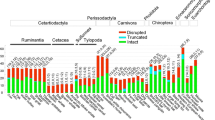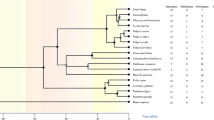Abstract
The perception of bitter taste is linked to the detection of toxins. Therefore, it facilitates avoiding the consumption of potential toxins in the diet. At the molecular level, bitter taste is mediated by taste 2 receptors (Tas2rs). Studies on Tas2r have made major advances in recent years. However, little is known about Tas2rs in Squamata, the second largest order of extant vertebrates. To explore the repertoire and phylogenetic relationships among Tas2r genes in Squamata, we identified and characterized Tas2rs from genome assemblies of 15 Squamata species. We observed considerable Tas2r contraction and expansion in the suborders Serpentes and Lacertilia, respectively. Phylogenetic and reconciliation analysis suggested that lineage-specific gene gains and losses could have led to the Tas2r contraction and expansion in Squamata. Different Tas2r repertoires in Serpents and Lacertilia also reflect their oral anatomical features and taste behaviors. Our findings offer novel perspectives into the study of taste and dietary protection in Squamata species.





Modified from (Rowland et al. 2015). a Dorsal (right) and ventral (left) palates of a generalized snake mouth. There are no taste buds on the tongue and there are a few on the lower jaw and the palate. b The tongue tip of most lizards is highly concentrated with taste papillae, indicated by denser hatching
Similar content being viewed by others
References
Adler E, Hoon MA, Mueller KL, Chandrashekar J, Ryba NJ, Zuker CS (2000) A novel family of mammalian. Taste Receptors Cell 100:693–702
Altschul SF, Gish W, Miller W, Myers EW, Lipman DJ (1990) Basic local alignment search tool. J Mol Biol 215:403–410
Atobe Y, Nakano M, Kadota T, Hisajima T, Goris RC, Funakoshi K (2004) Medullary efferent and afferent neurons of the facial nerve of the pit viper Gloydius brevicaudus. J Comp Neurol 472:345–357
Auen EL, Langebartel DA (1977) The cranial nerves of the colubrid snakes Elaphe and Thamnophis. J Morphol 154:205–222
Bauer AMK, Schuett AG, Lizards G (2002) The firefly encyclopedia of reptiles and amphibians. Firefly Books, Willowdale
Behrens M, Korsching SI, Meyerhof W (2014) Tuning properties of avian and frog bitter taste receptors dynamically fit gene repertoire sizes. Mol Biol Evol 31:3216–3227
Blum M (2012) Chemical defenses of arthropods. Elsevier, Amsterdam
Brodie ED, Tumbarello MS (1978) The antipredator functions of dendrobates auratus (Amphibia, Anura, Dendrobatidae) Skin Secretion in Regard to a Snake Predator (Thamnophis). J Herpetol 12:264–265
Caeiro-Dias G, Luís C, Pinho C, Crochet P-A, Sillero N, Kaliontzopoulou A (2018) Lack of congruence of genetic and niche divergence in Podarcis hispanicus complex. J Zool Syst Evol Res 56:479–492. https://doi.org/10.1111/jzs.12219
Chandrashekar J et al (2000) T2Rs function as bitter. Taste Recept Cell 100:703–711
Chen K, Durand D, Farach-Colton M (2004) NOTUNG: a program for dating gene duplications and optimizing gene family trees. J Comput Biol 7:429–447
Daly JW, Garraffo HM, Spande TF, Jaramillo C, Rand AS (1994) Dietary source for skin alkaloids of poison frogs (Dendrobatidae)? J Chem Ecol 20:943–955
Daly JW, Garraffo HM, Jain P, Spande TF, Snelling RR, Jaramillo C, Rand AS (2000) Arthropod–frog connection: decahydroquinoline and pyrrolizidine alkaloids common to microsympatric myrmicine ants and dendrobatid frogs. J Chem Ecol 26:73–85
Drewnowski A, Gomezcarneros C (2000) Bitter taste, phytonutrients, and the consumer: a review American. J Clin Nutr 72:1424–1435
Dumbacher JP, Menon GK, Daly JW (2009) Skin as a Toxin Storage Organ in the Endemic New Guinean. Genus Pitohui Auk 126:520–530
Gamow RI, Harris JF (1973) The Infrared Receptors of Snakes Sci Am 228:94–100
Glendinning JI (1994) Is the bitter rejection response always adaptive? Physiol Behav 56:1217–1227
Hayakawa T, Suzuki-Hashido N, Matsui A, Go Y (2014) Frequent expansions of the bitter taste receptor gene repertoire during evolution of mammals in the Euarchontoglires clade Mol Biol Evol 31:2018
Hong W, Zhao H (2014) Vampire bats exhibit evolutionary reduction of bitter taste receptor genes common to other bats. Proc Biol Sci 281:20141079
Hoogmoed MS (1989) Mehrtens JM (1987): Living snakes of the world in color: 1-480, over 540 colour photographs. £ 35.-. Sterling Publishing Co., New York and Blandford Press, House L, West Street, Poole, Dorset BH15 1LL, England Amphibia-Reptilia 10:93–94
Howse PE, Noirot C, Howse PE, Masne GL (1975) Chemical defences of ants, termites and other insects: some outstanding questions[C]//Le Masne, G.: Pheromones and defensive secretions in social insects. In: The proceedings of a symposium held on 18th, 19th and 20th September, 1975, at the University of Dijon. International Union for the Study of Social Insects (French Section), pp 23–40
Janssen S, Laermans J, Verhulst PJ, Thijs T, Tack J, Depoortere I (2011) Bitter taste receptors and α-gustducin regulate the secretion of ghrelin with functional effects on food intake and gastric emptying. Proc Natl Acad Sci USA 108:2094–2099
Jiang P et al (2012) Major taste loss in carnivorous mammals. Proc Natl Acad Sci U S A 109:4956–4961. https://doi.org/10.1073/pnas.1118360109
Keane TM, Creevey CJ, Pentony MM, Naughton TJ, Mclnerney JO (2006) Assessment of methods for amino acid matrix selection and their use on empirical data shows that ad hoc assumptions for choice of matrix are not justified. BMC Evol Biol 6:29
Kim U, Wooding S, Ricci D, Jorde LB, Drayna D (2010) Worldwide haplotype diversity and coding sequence variation at human bitter taste receptor loci. Hum Mutat 26:199–204
Kobayashi K, Kumakura M, Yoshimura K, Inatomi M, Asami T (1998) Fine structure of the tongue and lingual papillae of the penguin. Arch Histol Cytol 61:37
Krogh A, Larsson B, Von HG, Sonnhammer EL (2001) Predicting transmembrane protein topology with a hidden Markov model: application to complete genomes. J Mol Biol 305:567–580
Kroll JC (1973) Taste buds in the oral epithelium of the blind snake, Leptotyphlops dulcis (Reptilia: Leptotyphlopidae). Southwest Nat 17:365–370
Kumar S, Stecher G, Suleski M, Hedges SB (2017) TimeTree: a resource for timelines Timetrees divergence times Mol Biol Evol 34:1812
Laurie J. Vitt ERP (2007) Feeding ecology in the natural world. Lizard ecology: the evolutionary consequences of foraging mode. Cambridge University Press, Cambridge. https://doi.org/10.1017/CBO9780511752438.007
Li D, Zhang J (2014) Diet shapes the evolution of the vertebrate bitter taste receptor gene repertoire Molecular. Biol Evol 31:303–309. https://doi.org/10.1093/molbev/mst219
Liu Z et al (2016) Dietary specialization drives multiple independent losses and gains in the bitter taste gene repertoire of Laurasiatherian mammals. Front Zool 13:28
Massetti F, Kaliontzopoulou A, Gomes V, Rato C (2018) Variation in morphology and functional performance across distinct evolutionary lineages of the Moorish gecko (Tarentola mauritanica) from the Iberian Peninsula J Zool Syst Evol Res https://doi.org/10.1111/jzs.12249
Matsunami H, Montmayeur JP, Buck LB (2000) A family of candidate taste receptors in human and mouse. Nature 404:601–604
Mehrtens JM (1987) Living snakes of the world in. Color Soc Welf Stud 92:517–519
Meyerhof W (2005) Elucidation of mammalian bitter taste. Rev Physiol Biochem Pharmacol 154:37
Mitchell JC, Pague CA (2010) Amphibians and Reptiles of the Carolinas and Virginia by Bernard Mart of S, William M, Palmer; Joseph R, Bailey; Julian R Harrison Copeia 1980:946
Oonincx DG, van Leeuwen JP, Hendriks WH, Af VDP (2015) The diet of free-roaming Australian Central bearded dragons (Pogona vitticeps). Zoo Biol 34:271–277
Paradis S, Cabanac M (2004) Flavor aversion learning induced by lithium chloride in reptiles but not in amphibians Behav Process 67:11–18
Paradis E, Claude J, Strimmer K (2004) APE: analyses of phylogenetics and evolution in R language Bioinformatics 20:289–290
Parker HW, Gans C (1978) Snakes: a natural history. Quart Rev Biol 53:179
Price-Rees SJ, Webb JK, Shine R (2011) School for skinks: can conditioned taste aversion enable bluetongue lizards (Tiliqua scincoides) to avoid toxic cane toads (Rhinella marina) as prey? Ethology 117:749–757
Ronquist F, Huelsenbeck JP (2003) MRBAYES 3: Bayesian phylogenetic inference under mixed models Bioinform 19:1572–1574
Rowland HM, Parker MR, Jiang P, Reed DR, Beauchamp GK (2015) Comparative taste biology with special focus on birds and reptiles. In: Handbook of olfaction and gustation. Wiley
Schmidt JO (1990) Insect defenses: adaptive mechanisms and strategies of prey and predators. SUNY Press, Albany
Schmidt M, Nowack C, Wöhrmann-Repenning A (2010) On the presence of taste buds close to the vomeronasal organs in Gekkonidae Amphibia-Reptilia 31:355–361
Shanbhag B, Ammanna V, Saidapur S (2010) Associative learning in hatchlings of the lizard Calotes versicolor: taste and colour discrimination. Amphibia-Reptilia 31:475–481
Silva FM, Prudente ALDC, Machado FA, Santos MM, Zaher H, Hingst-Zaher E (2017) Aquatic adaptations in a Neotropical coral snake: a study of morphological convergence J Zool Syst Evol Res 56:382–394
Stangerhall KF, Zelmer DA, Bergren C, Burns SA (2011) Taste discrimination in a Lizard (Anolis carolinensis, Polychrotidae) Copeia 2001:490–498
Syed AS, Korsching SI (2014) Positive Darwinian selection in the singularly large taste receptor gene family of an ‘ancient’ fish Latimeria chalumnae BMC Genomics 15:1–15
Thompson JD, Higgins DG, Gibson TJ, Clustal W, Improving the sensitivity of progressive multiple sequence alignment through sequence weighting, position specific gap penalties and weight matrix choice. In: Nucleic acids research, 1994. pp 4673–4680
Uchida T (1981) Ultrastructural and histochemical studies on the taste buds in some reptiles. Archivum Histologicum Japonicum Nippon Soshikigaku Kiroku 43:459–478
Wang X (2004) Relaxation of selective constraint and loss of function in the evolution of human bitter taste receptor genes. Hum Mol Genet 13:2671–2678
Wang K, Zhao H (2015) Birds generally carry a small repertoire of bitter taste. Recept Genes Genome Biol Evol 7:2705–2715
Waterhouse A et al (2018) SWISS-MODEL: homology modelling of protein structures and complexes. Nucl Acids Res 46:W296–W303
Wiens JJ, Al E (2006) Why does a trait evolve multiple times within a clade? Repeated evolution of snakelike body form in squamate. Reptil Evol 60:123–141
Yang Z, Rannala B (1997) Bayesian phylogenetic inference using DNA sequences: a Markov Chain Monte. Carlo Method Mol Biol Evol 14:717–724
Yarmolinsky DA, Zuker CS, Ryba NJ (2009) Common sense about taste: from mammals to insects Cell 139:234–244. https://doi.org/10.1016/j.cell.2009.10.001
Young BA (1997) On the absence of taste buds in monitor lizards (Varanus) and snakes. J Herpetol 31:130–137
Zhao H, Zhang J (2012) Mismatches between feeding ecology and taste receptor evolution: an inconvenient truth. Proc Natl Acad Sci U S A 109:E1464; (author reply E1465)
Zhao H, Yang JR, Xu H, Zhang J (2010a) Pseudogenization of the umami taste receptor gene Tas1r1 in the giant panda coincided with its dietary switch to bamboo Mol Biol Evol 27:2669–2673. https://doi.org/10.1093/molbev/msq153
Zhao H, Zhou Y, Pinto CM, Charles-Dominique P, Galindo-Gonzalez J, Zhang S, Zhang J (2010b) Evolution of the sweet taste receptor gene Tas1r2 in bats Mol Biol Evol 27:2642–2650. https://doi.org/10.1093/molbev/msq152
Zhao H, Li J, Zhang J (2015) Molecular evidence for the loss of three basic tastes in penguins. Curr Biol 25:R141–R142
Zhong H et al (2017) Genomic evidence of bitter taste in snakes and phylogenetic analysis of bitter taste receptor genes in reptiles Peerj 5:e3708
Zhu K, Zhou X, Xu S, Sun D, Ren W, Zhou K, Yang G (2014) The loss of taste genes in cetaceans. BMC Evol Biol 14:218–218
Acknowledgements
This work was supported by the Special Fund for Forest Scientific Research in the Public Welfare (201404420) and the National Natural Science Fund of China (31872242, 31672313, and 31372220).
Author information
Authors and Affiliations
Corresponding author
Ethics declarations
Conflict of interest
The authors declare that they have no conflict of interest.
Additional information
Publisher’s Note
Springer Nature remains neutral with regard to jurisdictional claims in published maps and institutional affiliations.
Electronic supplementary material
Below is the link to the electronic supplementary material.
Rights and permissions
About this article
Cite this article
Zhong, H., Shang, S., Zhang, H. et al. Characterization and phylogeny of bitter taste receptor genes (Tas2r) in Squamata. Genetica 147, 131–139 (2019). https://doi.org/10.1007/s10709-019-00056-4
Received:
Accepted:
Published:
Issue Date:
DOI: https://doi.org/10.1007/s10709-019-00056-4




